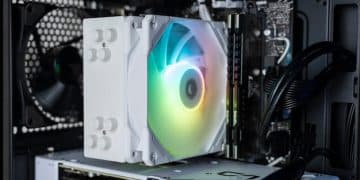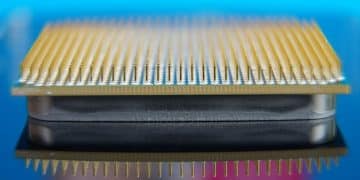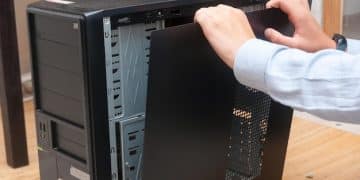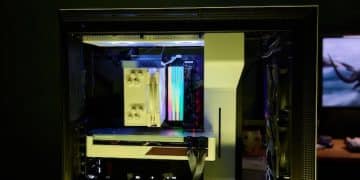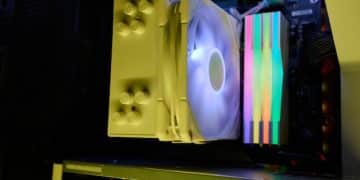Future-Proof Your Rig: Best Motherboard Upgrades for 2025

To future-proof your gaming rig in 2025, prioritize motherboard upgrades that support next-generation CPUs, faster RAM standards like DDR5, PCIe 5.0 for high-speed SSDs and GPUs, and robust power delivery systems, ensuring long-term compatibility and performance for evolving hardware.
For PC enthusiasts and gamers alike, the motherboard is more than just a circuit board; it’s the central nervous system of your entire system. As technology hurtles forward, ensuring your rig remains competitive means looking beyond today’s specs. This article explores how to Future-Proof Your Rig: The Best Motherboard Upgrades for 2025, delving into the critical features and considerations for maintaining cutting-edge performance as hardware demands inevitably increase, particularly within the dynamic gaming landscape.
The Foundational Role of Your Motherboard in 2025
In the rapidly evolving world of PC hardware, the motherboard serves as the critical backbone, dictating the capabilities and upgrade pathways of your entire gaming rig. For 2025, its role has become even more pronounced as components demand higher bandwidth, more efficient power delivery, and robust connectivity. Understanding why the motherboard is so pivotal goes beyond simply connecting parts; it’s about enabling a seamless ecosystem where every component can perform at its peak and integrate flawlessly with future innovations.
Socket and Chipset: Your Gateway to Next-Gen CPUs
The CPU socket and its accompanying chipset are arguably the most crucial features when considering a motherboard upgrade. These define which processors you can use, impacting everything from raw processing power to the number of PCIe lanes available. As we look towards 2025, both Intel and AMD are pushing the boundaries of what CPUs can achieve, with new architectures demanding updated socket types and chipsets capable of supporting their advanced features. Compatibility with these new standards is non-negotiable for future-proofing.
- Intel’s LGA Ecosystem: Future Intel processors are expected to continue evolving their LGA (Land Grid Array) socket designs, potentially moving beyond current generations to new ones optimized for increased core counts and enhanced integrated graphics.
- AMD’s AM Ecosystem: AMD’s AM platform has historically offered excellent longevity. For 2025, attention turns to how long the AM5 socket will persist and what new chipsets AMD will introduce to unlock the full potential of their Zen 5 and beyond architectures.
- Chipset Features: Beyond just CPU support, chipsets govern the number of USB ports, SATA lanes, and often the number of high-speed NVMe slots available, directly influencing storage and peripheral connectivity.
Choosing a motherboard with the latest socket and a robust, modern chipset ensures you won’t be forced into an early, unplanned upgrade cycle simply because your current board can’t house the next generation of processors. This initial decision lays the groundwork for years of high-performance computing.
Considering the rapid pace of technological advancements, particularly in CPU development, selecting a motherboard with a forward-looking socket and chipset is paramount. This strategic choice influences not only the immediate performance of your rig but also its capacity to smoothly integrate future CPU releases. Neglecting this foundational aspect can lead to significant bottlenecks, limiting the potential of high-end processors and forcing premature system overhauls. Therefore, investing in a motherboard that fully supports the anticipated innovations in CPU technology for 2025 and beyond is a wise decision for any serious PC builder or gamer.
RAM Evolution: DDR5 and Beyond
Memory technology, specifically RAM, continues its relentless march towards higher speeds and greater efficiency. As of 2025, DDR5 is firmly established as the dominant standard, offering significant improvements over its DDR4 predecessor. However, the nuances of DDR5 implementation and the potential emergence of even newer memory technologies warrant careful consideration when selecting a motherboard for future-proofing.
DDR5 Dominance and Speed Bins
DDR5 ushered in higher base frequencies, improved power efficiency (with VDD operating at 1.1V compared to DDR4’s 1.2V), and a dual-channel DIMM architecture, enhancing bandwidth. However, not all DDR5 memory is created equal. Motherboards vary in their ability to support extreme memory overclocking profiles (XMP/EXPO) and high-frequency kits. For a truly future-proof system, look for motherboards with robust memory VRMs (Voltage Regulator Modules) and optimized trace layouts that can handle faster DDR5 speeds, which are continually increasing.
Furthermore, the trend of memory speeds escalating year-on-year means that what is considered high-end DDR5 today might be mid-range by 2025-2026. A motherboard capable of comfortably running 6000MT/s+ DDR5 kits without stability issues provides a significant advantage. This ensures that you can upgrade your RAM in the future to even faster modules without needing a complete motherboard replacement.
The advancements in DDR5 memory are not solely about raw speed; they also encompass greater capacity potential per module and improved error correction capabilities. These factors become increasingly important for demanding applications, including high-resolution gaming, content creation, and professional workloads, where reliable and high-throughput memory is critical. Therefore, a motherboard’s support for advanced DDR5 features directly impacts the overall system responsiveness and capability to handle future software demands.
PCIe 5.0 and 6.0: Bandwidth for GPUs and NVMe SSDs
The Peripheral Component Interconnect Express (PCIe) standard is the literal highway for data within your PC, most notably for graphics cards and NVMe Solid State Drives (SSDs). While PCIe 4.0 is still prevalent, PCIe 5.0 is now standard on newer motherboards, and discussions around PCIe 6.0 are gaining momentum. For a future-proof build, understanding your PCIe lanes is paramount.
Maximizing Performance with Latest PCIe Standards
PCIe 5.0 doubles the bandwidth per lane compared to PCIe 4.0, offering 64 GB/s in a x16 slot. This extra bandwidth is crucial for several reasons:
- Next-Gen Graphics Cards: While current GPUs don’t fully saturate a PCIe 4.0 x16 slot, future graphics cards arriving in 2025 and beyond might. PCIe 5.0 ensures your GPU has ample bandwidth, preventing potential bottlenecks and allowing it to perform optimally.
- Ultra-Fast NVMe SSDs: PCIe 5.0 NVMe SSDs are already shattering previous speed records, offering sequential read/write speeds over 10,000 MB/s. Having at least one dedicated PCIe 5.0 M.2 slot on your motherboard is essential for blistering-fast game load times and file transfers.
- Future Expansion Cards: Beyond GPUs and SSDs, other high-bandwidth peripherals like capture cards, network adapters, and specialized AI accelerators will increasingly leverage PCIe 5.0 and future standards.
When selecting a motherboard, pay close attention to the number of PCIe 5.0 slots, particularly the primary x16 slot for the GPU and any M.2 slots. Some motherboards might offer a PCIe 5.0 x16 slot but only PCIe 4.0 M.2 slots, which is a significant downgrade for storage performance. Aim for a board that provides ample PCIe 5.0 connectivity where it matters most.

The transition to PCIe 5.0 is not merely an incremental upgrade; it represents a foundational shift in how high-speed data is transferred within a PC. For gamers, this means smoother gameplay and significantly reduced loading times, especially as game assets become more complex and require faster access. For content creators, the ability to rapidly process and transfer large files translates directly into increased productivity. Therefore, prioritizing a motherboard with comprehensive PCIe 5.0 support is a critical investment in the longevity and performance of your system.
Power Delivery and VRM: Stability for High-End Components
The Voltage Regulator Module (VRM) on a motherboard is responsible for delivering clean, stable power to your CPU. As CPUs become more powerful and complex, their power requirements increase, making a robust VRM design more critical than ever. For a future-proof gaming rig in 2025, an inadequate VRM can lead to unstable overclocks, thermal throttling, and even premature component degradation.
Ensuring Stable Power for Peak Performance
When evaluating a motherboard’s VRM, several factors are important:
- Phase Count: More phases generally indicate better power delivery, as the load is distributed across more components, reducing heat and improving efficiency. While marketing can be misleading (e.g., “doubled” phases), a higher true phase count is preferable.
- Component Quality: Look for motherboards that use high-quality MOSFETs, chokes, and capacitors. Reputable manufacturers often highlight these through their product specifications.
- Heatsinks: Large, well-designed heatsinks over the VRM components are crucial for dissipating heat, especially during sustained high loads or overclocking.
A strong VRM not only ensures stability for today’s high-end processors but also provides headroom for more demanding CPUs that may emerge in 2025 and beyond. It allows your processor to maintain its boost clocks for longer periods, preventing performance dips during intensive gaming sessions or demanding tasks. Overlooking VRM quality can severely limit the potential of even the most powerful CPUs.
Beyond the CPU, the VRM also plays a role in the stability of other components, including RAM. A well-designed power delivery system contributes to the overall reliability of the system, minimizing crashes and errors. For anyone planning to push their hardware to its limits, or simply expecting consistent, peak performance from their investment, paying close attention to the motherboard’s power delivery system is a non-negotiable step in future-proofing their rig.
Connectivity and Features: Beyond the Core Battle
While the CPU socket, RAM support, and PCIe standards form the core of a motherboard’s future-proofing capabilities, a range of other features and connectivity options significantly impact your overall user experience and the longevity of your rig. These elements often distinguish a good motherboard from a great one, especially in 2025 where diverse peripherals and high-speed networking are commonplace.
Essential I/O and Quality-of-Life Additions
Consider the following when assessing a motherboard’s broader feature set:
- USB Ports: Look for a generous number of USB 3.2 Gen 2×2 (20Gbps) and USB 3.2 Gen 2 (10Gbps) ports for high-speed external storage and peripherals. USB4/Thunderbolt 4 support is a significant bonus for ultimate connectivity and docking capabilities.
- Networking: 2.5GbE Ethernet is becoming the minimum standard for wired connections, with 5GbE or 10GbE providing future-proof headroom for faster internet and local network transfers. Wi-Fi 6E or Wi-Fi 7 is essential for robust wireless performance, especially in crowded wireless environments.
- Audio: High-quality integrated audio solutions (e.g., Realtek ALC1220 or higher-end codecs with dedicated amplifiers) can significantly enhance your gaming and multimedia experience without needing a separate sound card.
- Fan Headers and RGB Sync: Ample fan headers with robust control options allow for effective cooling management. Integrated RGB sync headers (e.g., Aura Sync, Mystic Light, Fusion RGB) simplify lighting control across your components.
- BIOS Features: A user-friendly and feature-rich BIOS/UEFI with easy overclocking options, fan control, and stable updates is crucial for long-term enjoyment and troubleshooting.
These features, while not directly related to raw CPU or GPU power, collectively contribute to a premium user experience and provide flexibility for future additions to your setup. A motherboard rich in connectivity options ensures you won’t be limited by old standards when new, innovative peripherals arrive on the market.

The thoughtful inclusion of advanced connectivity and quality-of-life features elevates a motherboard from a mere component holder to a comprehensive system hub. In an era where external devices and network performance are as critical as internal hardware, selecting a board that embraces these advancements will significantly prolong the relevance and enjoyment of your gaming rig. Investing in a motherboard that offers a broad spectrum of modern ports and network capabilities is a smart move for any gamer or professional looking to stay ahead of the curve in 2025.
Cooling Solutions and Aesthetics: More Than Just Looks
While often seen as secondary to raw performance specs, a motherboard’s cooling solutions and aesthetic design play a significant role in the longevity, stability, and overall appeal of your gaming rig. Effective heat dissipation directly influences component lifespan and sustained performance, particularly under heavy loads, while aesthetics contribute to the visual harmony of your build.
Integrated Cooling and Design Philosophy
Motherboards, especially higher-end models, now integrate advanced cooling features to manage heat generated by the VRMs, chipsets, and M.2 SSDs:
- Large VRM Heatsinks: As discussed, robust heatsinks are crucial for VRMs. Some motherboards incorporate finned designs or even heat pipes to maximize surface area and improve heat transfer.
- M.2 Heatsinks: High-speed NVMe SSDs, especially PCIe 4.0 and 5.0 models, generate significant heat under sustained load. Integrated, high-quality M.2 heatsinks are essential to prevent thermal throttling and maintain peak SSD performance over time.
- Chipset Heatsinks: Even chipsets, though less power-hungry than CPUs or GPUs, benefit from effective passive cooling to ensure long-term stability.
Beyond functionality, motherboard aesthetics have evolved. Many boards feature integrated RGB lighting, sleek designs, and customizable shrouds to complement modern PC cases and components. While not directly impacting performance, a visually appealing motherboard can tie your build together and enhance the overall experience. However, always prioritize functional cooling over purely aesthetic additions.
Choosing a motherboard that balances effective cooling with appealing design ensures that your future-proof rig not only performs exceptionally but also looks the part. This holistic approach to selection ensures that every aspect of your build contributes to its overall excellence and longevity in the competitive landscape of 2025’s gaming hardware.
Software Ecosystem and Manufacturer Support
The hardware specifications of a motherboard tell only half the story; the accompanying software ecosystem and the manufacturer’s commitment to support are equally vital for a future-proof system. This includes BIOS/UEFI updates, driver availability, and proprietary software utilities that enhance functionality and user experience.
The Importance of Ongoing Support and Utilities
A motherboard is a long-term investment, and robust software support ensures it remains relevant and secure. Key aspects to consider include:
- BIOS/UEFI Updates: Regular BIOS updates are critical for compatibility with new CPUs, memory kits, and addressing security vulnerabilities. A manufacturer with a proven track record of timely and effective BIOS updates is preferable. Features like BIOS Flashback (allowing updates without a CPU) can be incredibly useful.
- Driver Availability: Ensure the manufacturer provides up-to-date drivers for all integrated components, from audio codecs to network controllers. Outdated drivers can lead to performance issues or instability.
- Proprietary Software: Many manufacturers offer software suites for monitoring system health, overclocking, fan control, and RGB lighting synchronization. While some can be bloatware, high-quality utilities enhance the user experience and unlock the full potential of your hardware.
- Customer Support and Warranty: A strong warranty and responsive customer support are crucial should any issues arise. Researching user reviews regarding a manufacturer’s support quality can provide valuable insights.
A motherboard backed by a strong software ecosystem and dedicated manufacturer support provides peace of mind, ensuring your investment is well-protected and continues to perform optimally as new software and hardware standards emerge. This is a critical, often overlooked, aspect of truly future-proofing your gaming rig for 2025 and beyond.
| Key Upgrade Factor | Brief Description |
|---|---|
| 🚀 Next-Gen CPU Socket | Ensures compatibility with future Intel/AMD processors for sustained performance. |
| ⚡ DDR5 RAM Support | Crucial for higher frequencies and improved bandwidth over DDR4. |
| 🛣️ PCIe 5.0 Lanes | Essential for future GPUs and ultra-fast NVMe SSDs to prevent bottlenecks. |
| 🛡️ Robust Power Delivery | Guarantees stable power for high-end CPUs, crucial for overclocking and longevity. |
Frequently Asked Questions
▼
The motherboard connects every component—CPU, GPU, RAM, storage—and facilitates communication between them. Its design determines the maximum performance each component can reach, the types of upgrades possible in the future, and the overall stability and longevity of your system. Without a capable motherboard, even the most powerful individual components cannot function optimally or integrate seamlessly.
▼
DDR5 support is crucial for future-proofing in 2025. It offers significantly higher bandwidth and efficiency compared to DDR4, which is becoming a bottleneck for newer CPUs and applications. As demanding games and productivity software continue to evolve, DDR5 will provide the necessary memory performance, ensuring your system remains responsive and capable of handling future computational loads efficiently.
▼
While current graphics cards generally don’t saturate PCIe 4.0, next-generation GPUs arriving in 2025 and beyond are likely to benefit more from PCIe 5.0’s increased bandwidth. More importantly, PCIe 5.0 is vital for ultra-fast NVMe SSDs, drastically reducing game load times and speeding up data transfers. For a truly future-proof system, ensuring access to PCIe 5.0 lanes is a wise investment.
▼
VRMs (Voltage Regulator Modules) supply stable and clean power to your CPU. A robust VRM design is critical because modern CPUs can draw significant power, especially under heavy loads or during overclocking. High-quality VRMs prevent thermal throttling, ensure consistent performance, and contribute to the longevity and stability of your processor. They are key for unlocking the full potential of high-end CPUs.
▼
Beyond core hardware, evaluate the manufacturer’s software ecosystem and support. This includes timely BIOS/UEFI updates for new CPU and memory compatibility, updated device drivers, and useful proprietary utilities for system monitoring and control. Strong customer support and warranty policies also provide peace of mind, ensuring your motherboard remains functional and supported throughout its lifespan as technology progresses.
Conclusion
As we navigate towards 2025, the art of future-proofing a gaming rig, particularly through strategic motherboard upgrades, involves a delicate balance of anticipating technological advancements and making informed decisions today. The motherboard is unequivocally the central nervous system of any high-performance PC. Prioritizing features such as compatibility with next-generation CPU sockets, full support for DDR5 memory, ample PCIe 5.0 lanes for both GPUs and NVMe SSDs, and a robust power delivery system, is not merely about achieving peak performance in the short term. These considerations ensure your system possesses the foundational capabilities to embrace future hardware iterations, keeping your rig competitive and relevant for years to come. Ultimately, a well-chosen motherboard in 2025 isn’t just an upgrade; it’s an investment in a resilient, high-speed computing experience that adapts as the digital landscape evolves, standing ready for whatever challenges and innovations the future of gaming and computing may bring.

